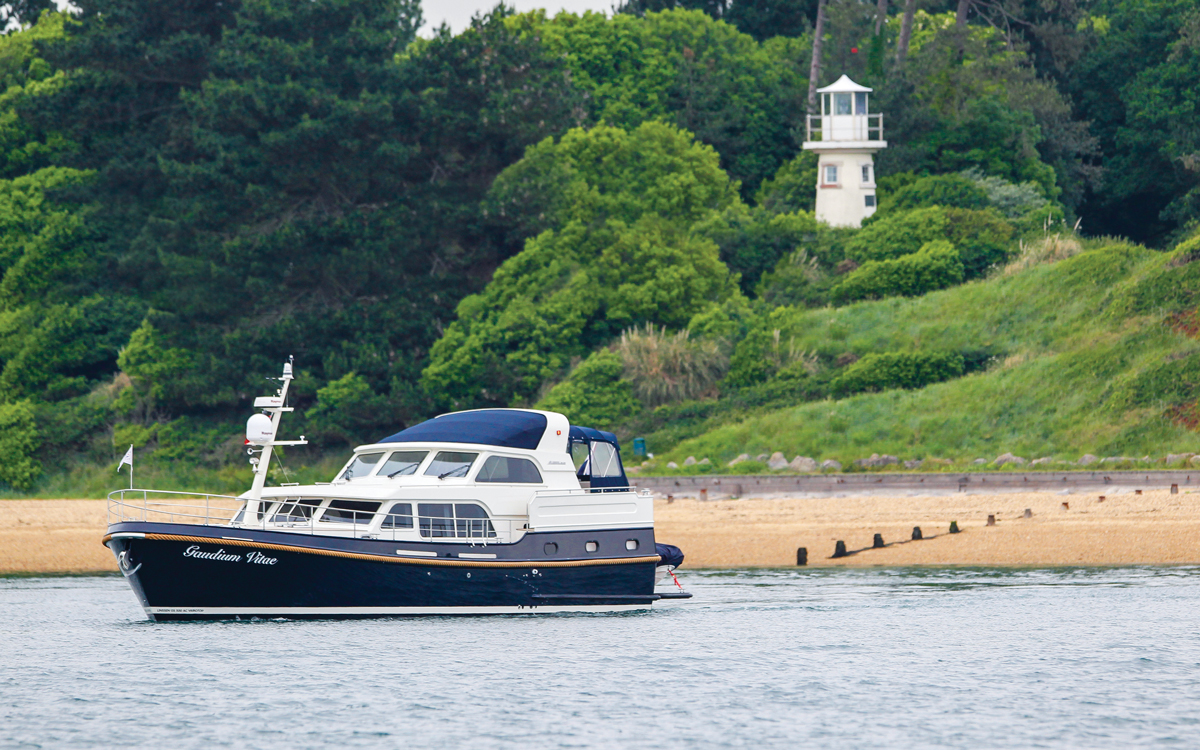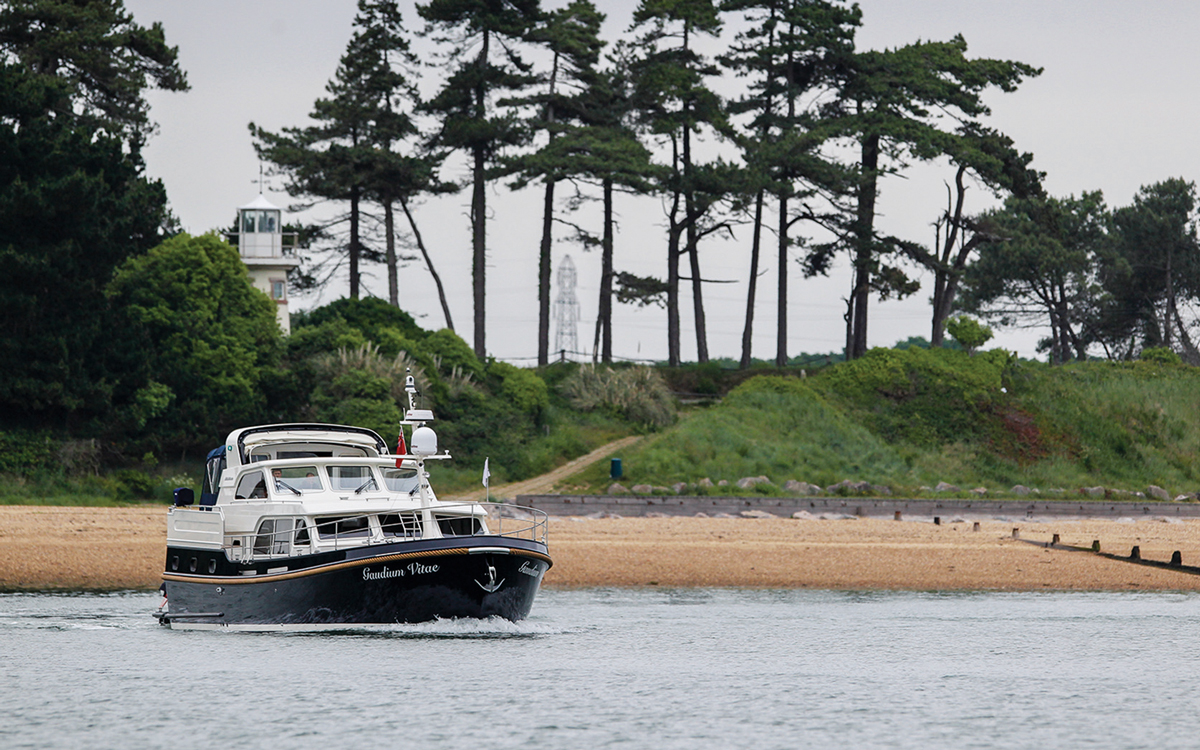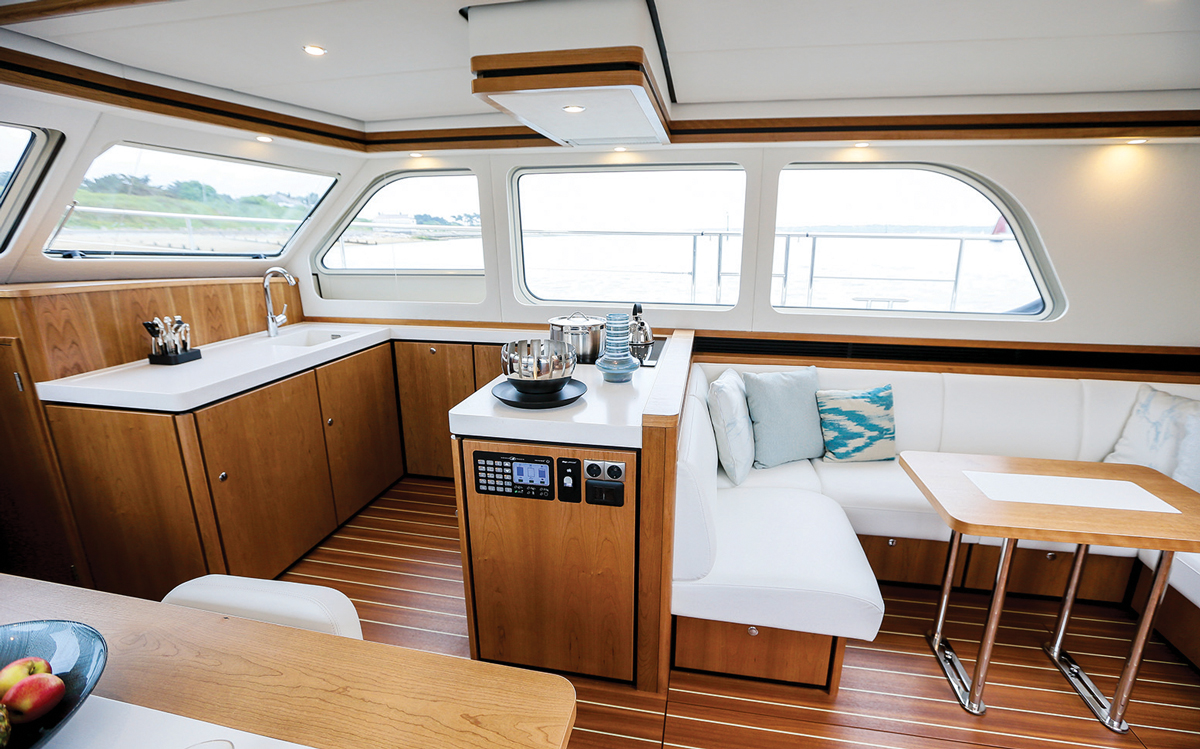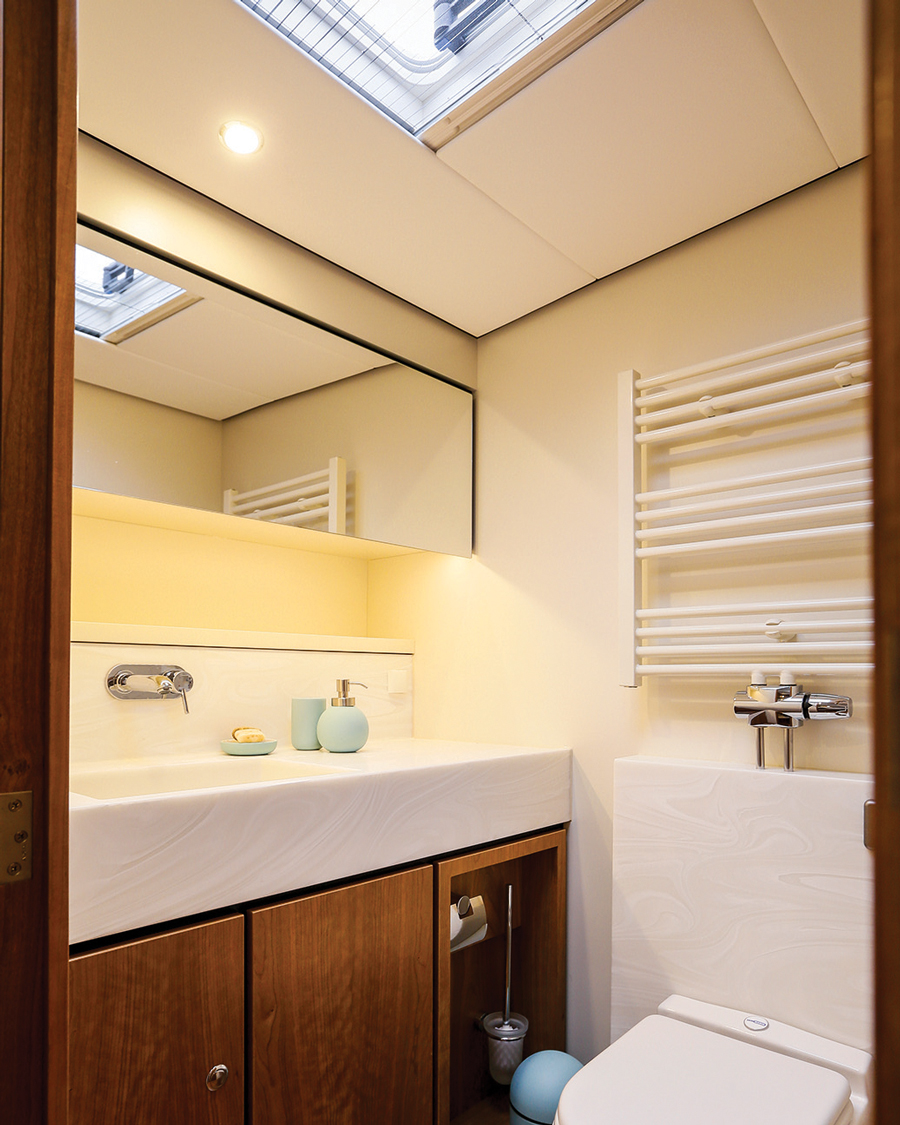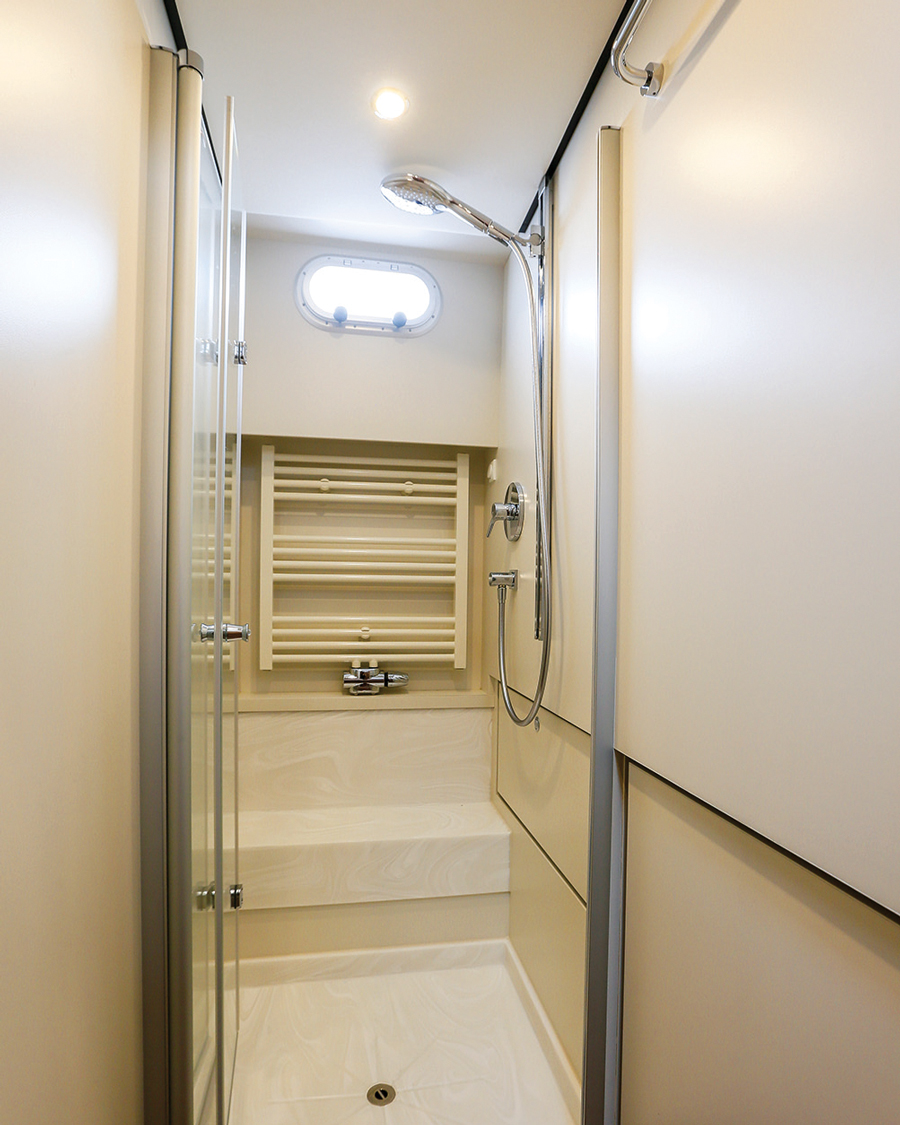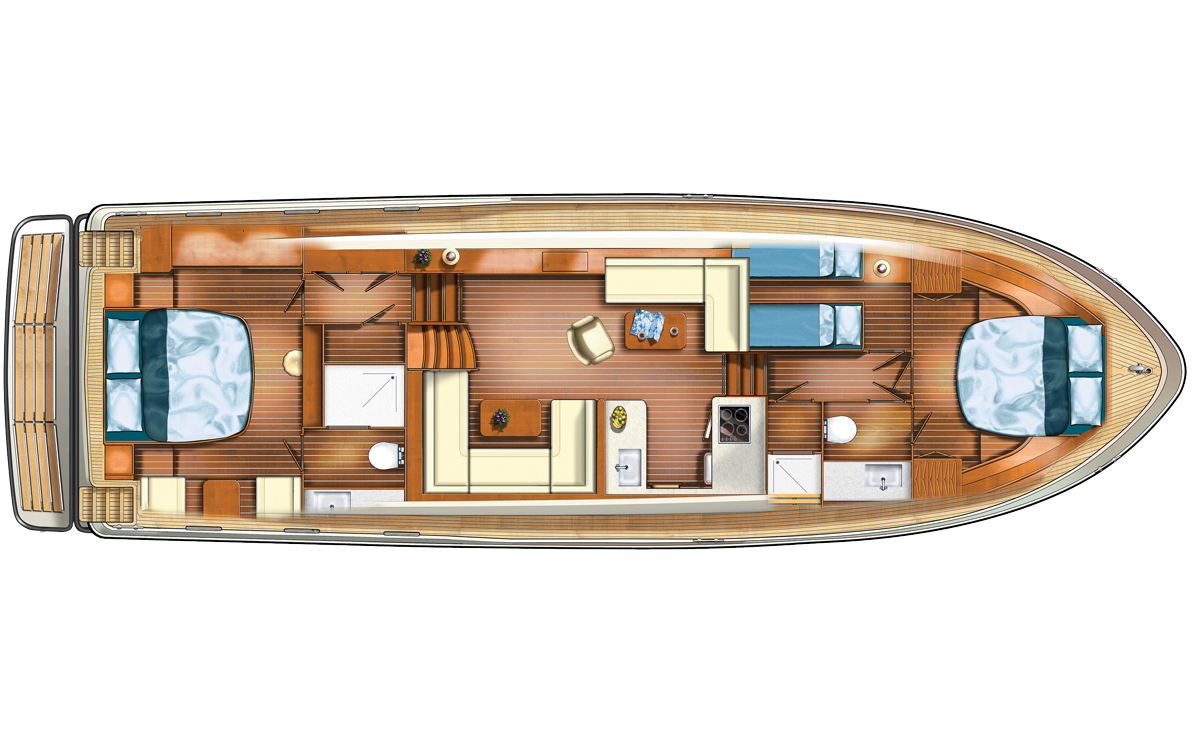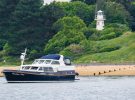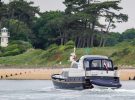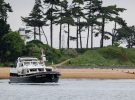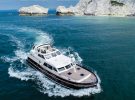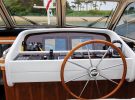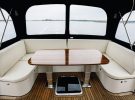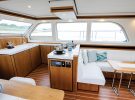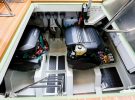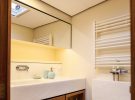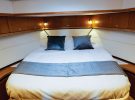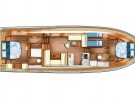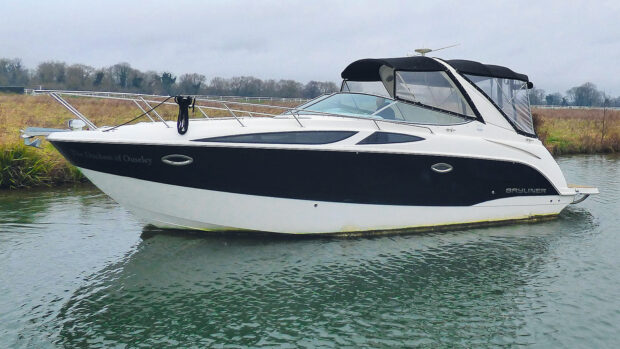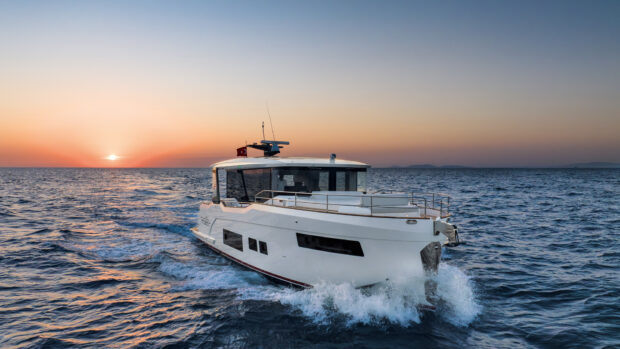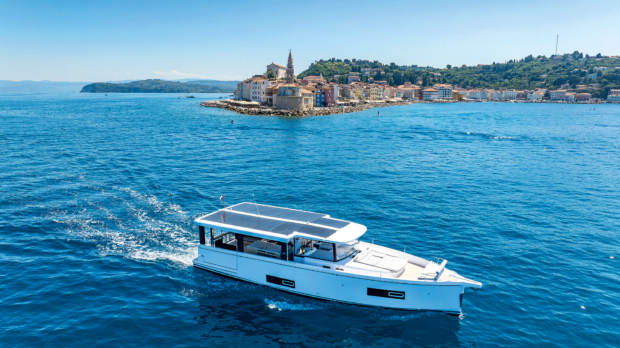The Linssen GS500 AC Variotop makes a trip to the UK for a test outside of its inland waterway comfort zone
There is a common perception that Linssen yachts are only suitable for navigating inland waterways. That certainly is not the case with the Grand Sturdy 500 AC Variotop (catchy name, huh?) lying before me on a hammerhead pontoon in East Cowes Marina.
The boat made the journey over to the Isle of Wight via the North Sea and swept along the English south coast to where it sits now; catching the evening sun, light dancing off its polished stainless steel. This is hull number one of the new GS500, the flagship of the range and, though it may not look like it, an all-new design.
Most of the work has been done below the waterline; above it the boat doesn’t look radically different to the 500s that have been coming out of the Maasbracht shipyard since 1996.

The hi-lo bathing platform is fitted as standard
Every tweak to the hull shape has been done due to a borderline obsessive attitude towards refinement and efficiency. New sterngear includes free-hanging propellers and rudders and P-brackets that are integrated into the hull construction to ensure the cleanest possible water flow for improved prop efficiency and less noise and vibration.
The engines are aligned closer to the keel again to facilitate better water flow and minimise cavitation. This forensic pursuit of refinement is crucial when designing a boat this quiet because every other noise is amplified, hence why the prop shafts are cocooned in seven layers of insulation and water-lubricated by an Aquadrive.
The engineroom is equally well insulated. The net result is church mouse decibel levels from the twin 5-cylinder Volvo Penta D3 150hp engines as we glide gently away from the pontoon and make a U-turn on the Medina. Nothing is hurried aboard a Linssen, especially not on one that weighs 30 tonnes plus fluids, a Williams 325 and cruising stores.

The GS500 is whisper-quiet on the move
I aim the bow downstream and noiselessly ease the throttles to 1,300rpm and a 6-knot trickle towards the Solent. The huge steering wheel spins effortlessly beneath my hands and the bow obeys obediently, nosing from port to starboard in a slow, controlled sweep.
The dashboard is a traditional mélange of leather and walnut punctuated by a pair of flush mounted Raymarine Hybrid Touch MFDs. They’re a stretch from the helm bench but Linssen has sensibly mounted the panel of soft keys on the flat area to the right of the wheel so that you can control both screens without having to lean forward.
It is a supremely comfortable driving position, which lends itself to the long lazy journeys that a Linssen owner must relish. You sit high, peering through a three-part windscreen over a long foredeck with excellent sight lines forward and back.
Article continues below…

Beneteau Swift Trawler 47 boat test – 24 hours on board

Linssen Grand Sturdy 52.9 review
Life in the slow lane, but with more space and more ingenuity than ever on the Linssen Grand Sturdy 52.9
£1270000
The layout of the raised deck means the driving position is also part of the socialising space thanks to a squishy sofa to port where guests can keep the skipper and navigator company. A nifty panel slides out from beneath the helm seat so that there is a place to rest drinks without the need for a bulky fixed table.
Wind the top down
It’s unfortunate that the Solent is as placid as the rivers that feed it for this test, meaning it isn’t possible to grasp how the GS500 would handle the rolling swell of a deep sea passage or even a short chop. The fact that it got here from the Netherlands under its own steam is testament to its ability and with a fuel capacity of 2,370 litres it has the range for serious cruising.
At 5.5 knots the range is nearly 5,000 miles with a 20% reserve and even at the more realistic cruising speed of 8.3 knots it will cover just shy of 900 miles.

The steering is wonderfully light and the wheel itself a delight to handle
There’s a nagging feeling, though, that if you were caught out in really rough conditions things could get quite uncomfortable. The boat would get through it I’m sure and the stabilisers would take the edge off but shifting a boat this big and heavy out of troughs with just 300hp is going to test the skill and determination of any skipper.
As we enter the Beaulieu River we peel back the Variotop roof to allow natural light and a cooling breeze to fill the main deck. Developed and engineered by Linssen, this roof is one of the GS500’s finest features, transforming the beautifully insulated wheelhouse into an open-air mezzanine where you can absorb your surroundings in glorious exposure to the elements. The mechanism is a work of art, pulling the canvas as tight as a drum to ensure the roof is totally weatherproof when closed.
Passing Gins Farm on the lower reaches of Beaulieu River with the roof open it’s hard to think of a finer way to travel in this environment. The oh-so comfortable helm bench has a trick up its sleeve too: at the push of a button it doesn’t just raise up but ascends high enough for you to sit almost completely clear of the windscreen – it’s quite something.

The flush-mounted screens are very hard to read from the helm seat
We reach the slipway at Buckler’s Hard and perform another U-turn. The engines aren’t enormous but there is good bite from the propellers which, when combined with the 7.5kW bow and stern thrusters (so powerful they need to be run off the generator), you can make the boat pirouette with minimal effort.
Moving around the GS500 is more akin to navigating a building than a boat because everything is so substantial and heavy duty. The teak-lined decks are a dream to negotiate and wide enough for two people to pass each other safely. There is a lack of dedicated fender storage, though, something you really notice when the fenders are this big.
Below, the feeling of solidity remains as does the building analogy with standard fit central heating, including radiators and towel rails in the bathrooms, double glazing and a galley equipped to domestic levels, aside from a full-height fridge/freezer.

Huge saloon windows soak the comfortable interior in natural light
If part of what you use a boat for is as a floating apartment then the big Linssen is ideal thanks to its bright, single-level living space that incorporates the galley, dinette and a more relaxed lounging space aft, opposite the must-have coffee machine.
The point is, though, even if you are on the move you can use this area of the boat. At speed on a planing boat the last place you want to be is below decks, but here, with the excellent view and sedate progress, you’d be as happy sitting down here with a book and a drink as you would be in the aft cockpit.
Some customisation of the interior is possible but there are boundaries. Linssen offers 35 different décor combinations, including six different colour palettes and seven interior trim packages, so there should be an option to suit most tastes.
Home comforts
The accommodation layout has been drawing people to Linssens for decades and they have not attempted to fix what isn’t broken. On the GS500, guests are split between a comfortable ensuite VIP double and a slightly more basic twin cabin on the port side, while at the other end of the boat is the full-beam master suite accessed via a dedicated corridor flanked by storage.

The master cabin features a huge island double bed
It has a huge 2m x 1.8m island berth, a dressing table, breakfast dinette and ensuite bathroom and with so much distance between it and the guest cabins, the owner will never be disturbed by those at the other end of the boat moving around during the night.
This is a boat built with liveaboards in mind and that has a positive influence on everything from the amount of interior storage to the superb modular engineroom layout. A powered hatch in the saloon lifts up to reveal a spotless machinery space with the hilariously petite D3s mounted with acres of space around them.
Everything is accessible and easy to inspect or replace. The systems are grouped into individual modules so everything from the climate control module (heating and air-con) to the fuel module (tanks and filters) is easy to find and in the same locale.

Our test boat was fitted with twin 150hp Volvo Penta D3s
The installation throughout is exemplary and a particularly useful touch is an option that automatically closes certain seacocks when the engines are switched off so important ones aren’t accidentally left open when the boat is unattended for long periods.
Our verdict
The GS500 starts at over €1.1 million even before you add tax, but this standard of engineering and built-in redundancy comes at a price. Some big-ticket items are fitted as standard, too, like teak decking, central heating and the double-glazed windows. Really, all that needs adding are the thrusters, navigation equipment, stabilisers and potentially a hydraulic bathing platform and/or passerelle.
Even in our reasonably short jaunt across the Solent it is evident that the Grand Sturdy 500 is a marvellous boat to live with. Yes it lacks useable outdoor space and the dowdy looks and rope necklace don’t set the heart racing, but it is steeped in charm and simply a lovely thing to spend time on.

As a tool for refined inland progress the GS500 is an absolute gem
To get the best from this boat you need to have time on your hands, it isn’t for those that can only use it at weekends as you aren’t going to get that far unless you cruise overnight. It’s designed to be used for weeks on end at a leisurely place where you can revel in its home-from-home comfort and waft quietly between destinations, forgetting the pressures of time restrictions and weather windows.
Our test may not have shattered the common theory that Linssens are best suited to inland work but whispering off down the Medina, with another jaunt across the North Sea and Holland in its sights, the Grand Sturdy 500’s offshore capability clearly passes muster.
Specification
 LOA: 54ft 0in (16.45m)
LOA: 54ft 0in (16.45m)
Beam: 16ft 0in (4.88m)
Draught: 4ft 2in (1.29m)
Displacement (light): 30 tonnes
Test engines: Twin Volvo Penta D3 150hp
Top speed: 10.5 knots
Cruising speed: 8.3 knots
Consumption: 17.5lph
Range: 899nm
Noise: 56 dB
Price (from): €1.4m (inc. VAT)
Fuel capacity: 2,370 litres
Water capacity: 960 litres
RCD category: B for 12 people
Design: Linssen Yachts & Bertine Creemers



